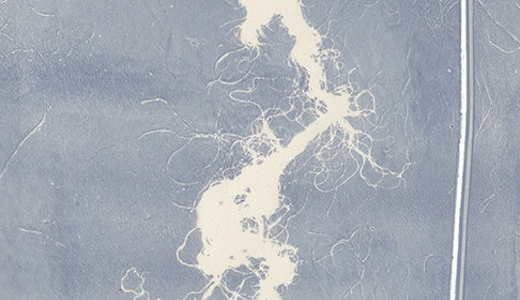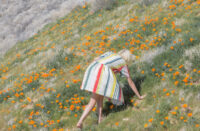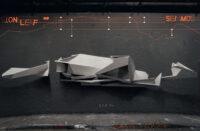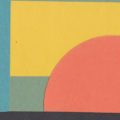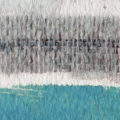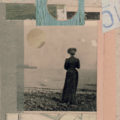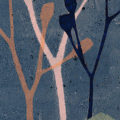Imagination stirred by sound, never obvious about sources or content and full of almost missing endless details.

Sound textures for deep listening
An ambient audio collage, sound textures for deep listening, created by two seasoned audionauts. This listening experience is a wonderful mystery, there are these 14 sonic events, sometimes with musical instruments, sometimes other things. Is there a story?
That would be something you might bring, what you get are the ideas expressed as words on the packaging (song titles, people, etc) and you get the strong cover art, but the biggest treasure is the mystery of the sound. Even without the clues on the packaging, you get a sequence of audio phenomenon, somewhat musical, somewhat something else. You try to make out what it is, and what is transpiring.
Imagination stirred by sound, never obvious about sources or content and full of almost missing endless details.
The mood is obscure, not obvious. What is obvious is that these sounds have been arranged with a lot of care, there is an element of discovery and puzzlement, otherwise there are quite interesting things to hear, sometimes I hear musical instruments being sounded, sometimes just odd things. Things altered and put together in a strange way. Each track is a new chapter in the set, there are no sing-along or dance moves to be copied. You are on your own, it works well for good old fashioned curious doings. This can reward the active listener in a unique way, as traditional theater has always intended to do.
Sparse and interesting elements of quixotic atmospheres put together, an organic flow and process that allowed the songs to breathe naturally with time and space.
With this much activity, creating an inventory of these contents seems like fun, but the quantity of detail is overpowering. So let’s skip that and just go for the whimsical impressions gathered during recent listening sessions. Like any good art, one time things appear in such a way, and another time the same things appear differently. Is it day or night? Is the weather changing how the sound is taken? What happened on the way to this moment? Sometimes such details influence how things are interpreted. We may or may not find the same things.
A dream-like and organic representation ::
What you will hear are slowly formed movements which evolve without escaping the focus of the audience’s attention, a dream-like and organic representation. There is no hurry anywhere, just flow with transitions, almost like music only with more mystery and experimental inventions.
The beauty of this type of expression is that you can invent your own story line as to what is happening. Maybe there is no story, maybe this album is just a series of odd or curious events that you hear. If you are impatient, there is no resolution. If you are curious, there might not be a fixed “conclusion” to decode.
The first track is “Tswana” (6:34) featuring the voice of Miriam Moseki, recorded twenty years ago in South Africa. Haunting, humming, with background activity and such, time hissing, piano shimmering, a cloud rhythm (the beat is sort of inverted, no pulse, only throbbing fuzz). “Casting Back” (4:75) reaching around in the dreamscape, some ancient fragments are sort of brought up, all done very slowly. “Voix De Lumière” (6:00) Imagine strings that bend, light that sings, or the voice of the light. There are bumps and ghosts, the voice of the light is what you need when the darkness is all there is.
“Rooms Reflect” (6:52) Voice: Tamalyn Miller. The feeling is slower. Still, bringing impressions of what to me is best described as “almost” activity nearby, night arrives about 2 minutes in. What I mean by “almost” is that the elements are present and in motion, a pattern is coming into focus, almost aligning but remaining beautifully hesitant, hazy and interesting, not simple. The birds almost bring the dawn. “Progressions” (4:45) brings piano melodics with rustling walkie-talkie voices somewhere nearby, not sure. The string effects flicker slowly, like odd percussion, echoing radium tones wafting past, very nice.
Time for the tragic sheen and the piano buzz. There is an emerging French lady (Milena Scriabine) who likes something because she does. I hear a shortwave door crack slowly: “M’s Dice” (4:28). The house of light is distant, it is a rumor in the darkness, “House Of Light” (6:00), where long strands vibrate, and way down below I sense a type of chirping robot crustacean hiding in the briney darkness. Sometimes things repeat but not enough for a rhythm, and there is almost a pattern. “Infinity Folds” (4:29) alternating things visit and vanish, density almost happens, melodies almost happen, I thought that I heard some kids nearby but they are gone now. “Crowds” (6:32) a piano, slightly, with wind in a cave nearby. The voice of Tamalyn Miller; on the sax: Magnus Gramén. I hear a crackling fire, a buzzy melody almost like the pattern of rain with fragments that click into form. There is an orchestra with ghosts, collectively almost making up its mind. They sound dreamy.
“Eternal Return” (5:32) I hear maybe some sandy castanets, a whirling girl ghost, the sound of hissing sand with rocks. Maybe we are now underwater. I think I hear a piano and a shortwave radio with Moondog woodwinds. Now focus on the “Back Of The Mirror” (4:36), micro fanfare fragments, fire night bugs and piano with crystalline melodic fragments. Sweet.
I got lost in a lunar cinema dream, the sound made me think that the piano was being haunted by a lost horn, so slow, so almost near, “Dusk Til Dawn” (4:36).
And an elegant bookend effect, reflecting the first track, “Tswana Dreaming” (5:12) brings the return of the haunting, humming, singing of the gentle and wise voice of Miriam Moseki.
Architectures Of Light is available on Handstitched*. [Bandcamp]
Heraclitus and the River.mp4 from stephen spera on Vimeo.
Tswana Dreaming from Bill Seaman on Vimeo.
Architectures Of Light is released in a limited edition CD run of 58 copies and comes with original collage cover art, acrylic fibre, hand-printed artworks—each release has a unique cover and hand-printed artwork, and is mounted on vintage book covers, packed in glassine bags with inserts for track-listing.
After following each other in differing capacities, both musically and visually, Bill Seaman and Stephen Spera have connected for the new Handstitched* release Architectures Of Light. As with all good collaborations, Seaman and Spera found a method that worked best for their musical-output, an organic flow and process that allowed the songs to breathe naturally with time and space.
Sending each other libraries of potential ideas, then building up layers of sounds, adding to each other’s work as time progressed. Multiple iterations created by each artist on the album formed the audible backbone and it was added-to, and/or broken-down to form alternative viewpoints, resulting in moments of slowly-formed movements which evolve without escaping the focus of the audience’s attention.
There is a depth in the work of Seaman and Spera that is noticeable in the form of languages and interpretation, using found-sound, evocative vocal samples from past archives and degraded/fluctuating tape loops. Two songs have accompanying visual works, one produced by Seaman and one by Spera, both videos marry the visual and musical language found inside the music with dream-like and organic representations for each respective work.
Bill Seaman: Piano, DX7, non-location recordings, digital percussion, arrangements
Bill Seaman is a composer, musician, artist and media researcher. Seaman’s artworks often investigate a media-oriented poetics through various technological means – Recombinant Poetics.
Such works often explore the combination and recombination of media elements and processes in interactive and generative works of art. Seaman enfolds image/music/text relations in these works, often creating all of the media elements and articulating the operative media-processes involved. He is self-taught as a musician/composer. More recently Seaman has also been exploring the creation of a transdisciplinary search engine related to Neosentience—the future of AI and Robotics, called The Insight Engine. This work is a mixture of conceptual art and science—Recombinant Informatics.
Seaman has undertaken many collaborations in the past. He works in a very sculptural manner in the composition of his music, in part, drawing upon various live libraries of his collaborators, as well as libraries of his own DX7, abstracted beats, non-location recordings, analogue synth and piano with live instruments.
Seaman works with these in Ableton Live, creating new pieces from assembled and processed materials. He also often creates videos to accompany his music production. Seaman is Professor of Art, Art History and Visual Studies at Duke University, Co-Director of the Emergence Lab, and Author of many books and papers. He has worked with many interesting labels in the past including Cotton Goods, Facture, Eilean, Fluid Audio, Oscarson and Rottenman Editions.
Stephen Spera: Synth, tape deck, devices, keyboards, field recordings, mixing.
Stephen Spera is a well-known Artist in Sound, Photography, and the Plastic Arts. His work is in permanent collections from the Getty to MOMA, and he has recorded on many fine labels, from Parvoart, Trace, Tessellate, Dust Archive, Editions Vaché, and more. His sound works have received much critical acclaim, and he is also one half of the duo Spirit Radio, with Tamalyn Miller. Spera is known for his work in Tape Music, and uses everything from broken cassette players to Adobe Logic to achieve his unique sound.
For more information, visit handstitched.net.






